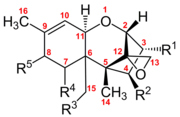This article needs additional citations for verification. (October 2008) |

The trichothecenes are a large family of chemically related mycotoxins. They are produced by various species of Fusarium, Myrothecium,Trichoderma/Podostroma, Trichothecium, Cephalosporium, Verticimonosporium, and Stachybotrys. Chemically, trichothecenes are a class of sesquiterpenes.
The determining structural features which cause the biological activity of trichothecenes are the 12,13-epoxy ring, the presence of hydroxyl or acetyl groups at appropriate positions on the trichothecene nucleus, and the structure and position of the side-chain. They are produced on many different grains such as wheat, oats, or maize by various Fusarium species including F. graminearum, F. sporotrichioides, F. poae and F. equiseti.
Some molds that produce trichothecene mycotoxins, such as Stachybotrys chartarum, can grow in damp indoor environments. It has been found that macrocyclic trichothecenes produced by S. chartarum can become airborne and thus contribute to health problems in humans.[1][2] A poisonous mushroom native to Japan and China, Podostroma cornu-damae, contains six trichothecenes, including satratoxin H, roridin E, and verrucarin.
- ^ Detection of Airborne Stachybotrys chartarum Macrocyclic Trichothecene Mycotoxins in the Indoor Environment
- ^ Etzel RA (2002). "Mycotoxins". JAMA. 287 (4): 425–7. doi:10.1001/jama.287.4.425. PMID 11798344.